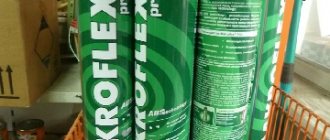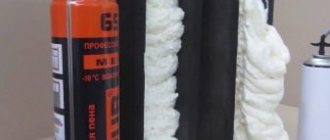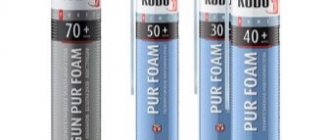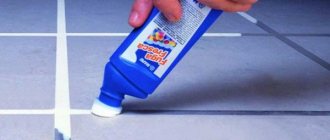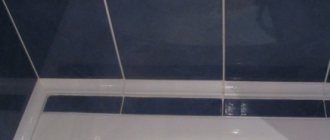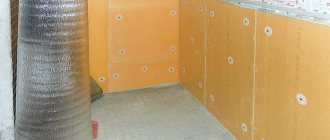A comfortable and cozy home is the natural desire of every person. When reconstructing, repairing or constructing housing, a large role is given to the processes of sealing various structures and openings. To provide reliable protection against moisture on different surfaces (floors, windows, doors, foundations), you need high-quality waterproofing. Waterproof polyurethane foam, which is a new generation building material with good performance characteristics, is suitable for this purpose.
Foam Features
The rapid development of the construction industry leads to the emergence of new materials. These include moisture-resistant polyurethane foam, which is used to seal joints, gaps and voids. The inclusion of certain components in the composition gives the substance moisture-resistant and heat-insulating qualities. Foam quickly replaced mineral wool tape, and installation began to be used instead of bitumen mastic where appropriate. The features and advantages of the material include:
- High degree of resistance to mechanical stress.
- Simplicity and ease of use, good foaming.
- Adhesion to different surfaces, low thermal conductivity.
- Pronounced waterproofing and soundproofing properties.
- Preserving the integrity of the seam by compensating for deformations.
- Resistant to paints and varnishes, easy to clean.
In terms of composition, waterproof polyurethane foam is classified as a polyurethane product. Due to the reaction of polyesters and isocyanates, which occurs a few minutes after surface treatment, the substance polymerizes. Moisture-resistant foams for installation work come in one- and two-component types. The difference between them is the speed of hardening and shelf life.
Atmospheric moisture serves as a catalyst for the polymerization of one-component compositions. Therefore, at negative temperatures or in extreme heat, the air contains a minimum amount of moisture, and before applying polyurethane foam for waterproofing, the surface to be treated must be moistened with water.
Two-component formulations are a tube with two sections with a separating membrane. Components that are under pressure react after the septum is removed. Therefore, the foam hardens quickly when applied; it must be used within 5-10 minutes. Thanks to the separation of components, it became possible to add additives to the installation sealant that improve various characteristics of the foam - density, waterproofing properties, tightness, increase in volume.
Important: Foams have one significant drawback - they react to exposure to ultraviolet rays. Therefore, after application, the hardened mass is puttied, plastered or painted, creating a reliable protective layer.
Manufacturers rating
Since sealing joints in rooms with high humidity is one of the most popular procedures, many manufacturers of professional polyurethane foams produce their products in two versions - standard and waterproof. Among them there are products for different temperature conditions. Before purchasing, you should read the rating:
- A wide range of waterproof polyurethane foams is produced by the Polish company Tytan . Among them there are summer and winter, professional and household options. They are well suited for heat and sound insulation work. Some products contain antibacterial components that prevent the contamination of surfaces by mold and mildew.
- Hauser company produces all-season foams that can withstand extreme frosts (down to -50 degrees). However, you cannot work with them in such conditions: during installation and for 24 hours after that, the air temperature should not fall below -10 degrees. After hardening, the foam can be trimmed, plastered, or painted. It sets quickly - within 5-10 minutes.
- Makroflex is an Estonian brand that produces a wide range of waterproof foams in cans of different sizes: with a tube and for a gun, for winter and summer. Before opening, the bottle can be stored for one year from the date of manufacture. Professional compositions are resistant to precipitation. They can be painted and plastered without primer.
- The Belgian company Soudal produces waterproof household foams - polyurethane and prepolymer. The latter are intended for winter use and have excellent performance properties: vapor permeability, resistance to fungus and mold, extreme frosts and even ultraviolet radiation. The line includes options that are not subject to fire. Installation of this product is carried out at a temperature not lower than -10 degrees.
Sealant cannot be applied to some types of materials. These include silicone, polyethylene, Teflon products, as well as items coated with oil or grease. Foam does not stick to these materials in principle.
What to consider when choosing
Assembly sealants are classified into professional and household foams. Experienced builders use spray cans with a gun outlet to accurately dose the amount of blown composition. Tubes for household use are equipped with a polyethylene tube. When choosing mounting waterproof foam for sealing, take into account the following parameters:
- For waterproofing work, it is important whether the mounting foam allows water to pass through - you need to choose waterproof sealants.
- Output volume – construction teams work according to cost estimates. Masters choose foams with high yield.
- The degree of primary and secondary expansion of waterproof polyurethane foam. This is important for proper filling of voids.
- Fire resistance (fire resistance). There are foams that do not support combustion when exposed to an open flame.
- Operating and operating temperature range. Frost-resistant sealants can be used at sub-zero temperatures.
In addition, craftsmen take into account the drying speed of the foam and the time of formation of the surface film. The quality of a waterproof sealant can be assessed by the appearance of the frozen mass. The proportion of the caliber of the bubbles formed must be maintained. Voids, uneven structure and deformations after complete hardening of the sealant are eliminated.
Purpose and scope of use
Polyurethane foams are characterized by universal applicability for industrial and domestic purposes. The main purpose is to fill voids around fixed structures. After squeezing out of the can, the sealant increases in volume several times, completely filling the foamed space. Moisture-resistant polyurethane foam is suitable for outdoor use and indoor waterproofing. Areas of use of waterproof polyurethane sealant:
- Noise insulation that prevents the penetration of noise from the street, from operating air conditioners, heating, and water heating devices. When filling holes in communication systems, door and window openings, the noise level will be minimal.
- Thermal insulation, the purpose of which is to protect rooms from cold air. The foam prevents the formation of cold bridges in the area of windows and doors, and adheres well to concrete, metal, and wooden bases.
- Waterproofing is the main purpose of polyurethane foam with moisture-resistant characteristics. The material can be used in rooms with high humidity; most often, foam is used for waterproofing bathrooms.
Polyurethane-based sealant is suitable for filling voids in roof structures; it can be used to seal pipe joints. Less commonly, the composition is used as an adhesive component, connecting materials of different structures. Tightness and waterproofing properties are the main advantages of waterproof polyurethane foam.
Attention: The use of foam installation does not replace the need to connect different structures using fastening materials. When working with soft bases, you need to take into account the expansion factor of the composition several times. In order not to deform plastic and plasterboard structures, fixing spacers are installed before foaming.
Polyurethane foam and its types
No type of construction or renovation work can be imagined without the use of this material. Using this tool, you can mount various elements of the room. Let's first look at the applications of this product.
Areas of use
There are different areas of use:
- The material is used for sound insulation. Polyurethane foam can prevent the spread of noise from air conditioning, heating appliances, and water pipes. To do this, all holes in the walls and pipe joints are filled with this building product. That is, for sealing.
- Carrying out thermal insulation and waterproofing. Thanks to this product, you can seal defects in the roof. You can insulate rooms that are cold. You can fill all the voids that are around pipes, doors and windows. The main property of this product is sealing.
- Carrying out gluing. Thanks to it, it is possible to connect different components that are made of a variety of materials.
Using polyurethane foam
Let's consider the most necessary recommendations:
- First you need to read the instructions provided by the sealant manufacturer.
- Before starting work, the can must be shaken.
- To ensure excellent adhesion (adhesion to the surface), the coating must be moistened before applying the substance.
- If the procedure will take place at low temperatures, it is necessary to heat the can. This can be done in warm water. The polyurethane foam should heat up to five degrees Celsius.
- If you need to fill holes that are vertical, then filling occurs from the bottom up.
- The foam becomes hard only eight hours after application. After you have applied it, cut off the excess material after 60 minutes.
- Ultraviolet rays have a detrimental effect on this product, so it is necessary to coat it with a primer, paint or plaster.
Be sure to follow these tips.
Properties of polyurethane foam
Now let's look at the technical characteristics and properties of the building material:
- The application process can be carried out using a gun with an applicator. Thanks to this construction tool, the procedure will go much faster.
- The product allows you to fill voids between structural components, thereby increasing their waterproofing characteristics and strength. Relatively moisture resistant, not afraid of moisture.
- Foam in aerosols acquires its relevance at low temperatures.
- The material has a high level of resistance to mechanical damage.
- The product sets and is fixed in a short period of time.
Thanks to these properties, construction foam can be used in different places:
- It is used on boats and rafts to seal various cracks.
- It can be used to seal cracks and holes in the roof.
- Fills voids in window and door frames.
- The voids that are located around heating and water pipes are filled.
- Masonry made of stone or concrete acquires waterproofing properties when cracks are sealed.
- Sand dams can also be protected from water damage.
When foam for waterproofing interacts with water, it begins to swell and increase in volume. Afterwards it hardens within 24 hours.
Waterproof polyurethane foam for the bathroom does its job perfectly. During the installation of the bathtub, cracks appear between the walls, which can be repaired using polyurethane foam. How to do it?
When insulating a bathroom, foam is used as follows:
- Buy a spray can that is intended for household use.
- It should be kept in a room at room temperature for some time, after which it should be shaken.
- The foam should be squeezed out carefully and carefully into the cracks.
- When the product has time to dry, it is necessary to cut off the excess parts. This can be done using a knife.
- In order to improve the waterproofing characteristics, it is necessary to apply grout.
Might be interesting
Waterproofing
Foundation waterproofing: optimal choice of technology
Waterproofing
Clean water is the key to health, waterproofing concrete…
Waterproofing
Instructions for waterproofing a swimming pool
Waterproofing
Selection of materials, methods of waterproofing work...
Polyurethane foam for waterproofing work can be purchased in cylinders. Its type is a liquid propellant or prepolymer. As soon as the product leaves the container, the hardening reaction begins, after which rigid polyurethane foam is formed.
Since this building product has a low level of electrical conductivity and moisture resistance, it is most often used for sound insulation. Foam can be used both for external and internal work. The foam is waterproof.
Types of polyurethane foam
In total, you can find two types of this substance on the construction market:
- professional product;
- household product.
Professional waterproofing foam is applied only using a specially designed gun with an applicator.
The household substance is applied using a spray can. When you use construction material, do not throw away a can that is already half empty. You need to insert the screw into the plastic tube. After some time, if you need, you can use the same foam. If this is not done, the product will simply harden and be unusable.
Features of the household product:
- Has a large expansion during hardening.
- The can is not always of high quality because most of the product is not used.
- The output canister has a small volume.
Features of a professional product:
- The canister at the outlet has a large volume.
- The structure of the material is dense.
- Expansion: 10 to 40 percent.
Any type of product must be applied carefully and evenly. The applied layer must be thin. Thanks to this, you can save substance, and then you will not need to eliminate unnecessary parts.
How to work with foam correctly
The technology of working with waterproofing polyurethane foam is to uniformly and quickly distribute the composition over the surface being treated. Before foaming, you need to check the expiration date of the material - indicated on the can. It doesn’t hurt to read the manufacturer’s instructions on under what conditions and for what the sealant can be used. Household foam is distributed using a plastic tube, which is included in the kit; for professional compositions you need a construction gun. Application Features:
- Prepare the surface for processing - sweep away debris, dust, install spacers if necessary.
2. You must wear gloves and a mask, and shake the can of waterproofing material.
3. Moisten joints, gaps or voids with plain water. Remove the protective cap from the can and install a tube or gun.
4. During operation, the foam tube should be held upside down, directing the sealant stream perpendicular to the surface.
5. The space is filled to a third of the depth - after hardening, the composition expands and increases in volume.
How to use polyurethane foam correctly
Before starting work, the surface must be cleaned of dirt .
This can be done with a damp soft cloth: the foam sticks to a wet surface better than to a dry one. Before applying the sealant, you need to protect your skin from possible contact by wearing closed clothing. A respirator, safety glasses and gloves are also prepared.
The cleaned surface must be degreased to improve adhesion. Then the surface is moistened.
If work is carried out in a cold room, the foam should be slightly heated (the recommended temperature is indicated on the packaging). This can be done by placing the balloon in warm (20-25 degrees) water. Another option is to keep it in a heated room for several hours.
Under no circumstances should you use a water bath or elevated temperatures in general, otherwise the bottle may explode.
Before starting work, the container must be shaken. Then the cap is removed from it and the tube is installed (or the bottle is placed in the gun, depending on the type of composition).
When working, the cylinder is held upside down . This is important because otherwise the gaseous part of the contents will come out first, and the liquid foam will remain in the bottle. The substance must be directed at right angles to the surface to be treated.
Valera
The voice of the construction guru
Ask a Question
If you use household foam, you don’t need to squeeze out too much of it: just fill the gap 30%. This is due to the strong increase in volume of the sealant shortly after application. Professional products do not have this property, so they are immediately squeezed out as much as needed.
If splashes have stained adjacent surfaces, they should not be removed with water or a wet cloth . Trying to do this will only speed up the expansion of the foam and its setting. For the procedure, acetone or special solvents are used . Excess is cut off 8 hours after application.
Some sealants cannot be cut. In this case, it is important to especially carefully monitor the amount of foam squeezed out.
The frozen surface can be painted to protect it from ultraviolet radiation.
Terms of use
On each package, the manufacturer indicates the conditions for using the material. These parameters may vary slightly depending on the brand and additives included in the waterproof sealant. There are products for interior and exterior work, with an increased level of fire resistance, sound insulation, and frost resistance. Basic rules that should be followed when sealing seams to seal joints and cavities with polyurethane foam:
- The optimal ambient temperature is +20°C, but foam can be used at temperatures from -10 to +30°C.
- Humidity indoors or outdoors should not exceed 60% for the sealant to cure well.
- It is imperative to prepare the work surface before applying the composition.
You can seal seams and gaps in the bathroom, on the street, in the kitchen - waterproof foam does not allow moisture to pass through and reliably “seals” pipe joints and cracks formed after the installation of various structures. If the composition is used at negative temperatures outside, snow, ice, and frost are carefully removed from the surface. When the flammability class is indicated on the foam, such material is suitable for waterproofing in compliance with fire safety rules.
Is polyurethane foam suitable for waterproofing?
In many European countries, it is prohibited to use polyurethane foam in the construction of objects. If you use this substance to seal windows, then you must cut off the excess parts and blow them out with silicone. Thanks to this, you can prevent the penetration of moisture and dampness.
Polyurethane foam is hygroscopic; it absorbs water after a certain period of time.
After a certain period of time, due to environmental factors and the influence of ultraviolet sunlight, the characteristics of the product deteriorate and it becomes unusable. According to studies, the foam absorbed moisture like a sponge. There are foams for different seasons; depending on this, winter and summer products are used. You can also purchase all-season polyurethane foam.
Waterproof material for bathroom
The main area of use of moisture-resistant material is sealing bathrooms. If there are cracks in the cladding in the room or there is a void between the plumbing and the wall, a puddle will remain on the floor after taking a shower. Consumers reasonably wonder whether polyurethane foam allows water to pass through or not. Does not leak if you choose a moisture-resistant sealant. Features of using foam in the bathroom:
- Problem areas in the lining of the room can be foamed, and tiles, tiles, or a border can be glued on top.
- Moisture-resistant polyurethane foam does not interact with water, which allows you to fill cracks and glue joining fragments.
- The use of waterproof foam prevents moisture from penetrating underneath the tile base.
- The foam is not electrically conductive and has a certain flammability class.
- Waterproof foam for the bathroom can be used to install plumbing fixtures.
Before installing a bathtub, sink, or toilet, you need to replace old pipes with new plastic equipment. Then in a few months you won’t have to deal with repair work. The bathtub is placed on a stand (podium) or legs, and all the resulting joints are sealed with a waterproof foam substance that does not absorb water. In order for the foam to penetrate into the joints between the floor and the bathtub, the gap must be more than 1 cm. After drying, the foam is cut off with a knife and covered with protective (also moisture-resistant) enamel.
Note: Used foam tubes should not be left in the sun or burned. In bathtubs with hydromassage, you need to use high-quality polyurethane sealants that do not accumulate static electricity.
Two-component polyurethane foam
GFlex offers building materials from Den Braven, Tremco illbruck, Tytan, SOUDAL and other manufacturers. Our own transport service allows us to deliver goods to any city in Russia in a short time. We transport the cargo free of charge to a transport company for shipment throughout Russia (Avtotradig, Business Lines, Zheldor, Pack), to the Far East, Kamchatka and Sakhalin (GROUPST company), to Kazakhstan and Belarus (as agreed with the customer).
Two-component polyurethane foams are polymer materials consisting of two substances. The main thing is to fasten the structures being connected and seal the seams between them. The second substance is a catalyst (activator) and promotes a more intense adhesion process.
Application of polyurethane foam
Two-component installation foams are used for the following construction and repair work:
• sealing of holes and seams in roof structures;
• installation of door and window structures;
• filling the space between the parts of vertical ceilings, partitions, flat roofs for thermal and acoustic insulation;
• fixing tiles and wall panels;
• installation of internal doors without mechanical connections;
• filling voids and cracks, including closed ones, into which moisture does not enter;
• fastening and soundproofing of bathtubs and shower trays.
You can order polyurethane foams from Gflex by calling the numbers listed in the “Contacts” section.
Foam manufacturers and material costs
Unlike conventional polyurethane foam, the moisture-resistant composition is presented on the market with a less extensive range of products. The properties and waterproof characteristics of polyurethane foam depend on the component composition. Typically, manufacturers produce foams in a standard and moisture-resistant version so that consumers have a choice. To waterproof bathrooms, you should give preference to more expensive foam that does not absorb moisture. Popular manufacturers of sealants and approximate prices for products:
- Household all-season foam Tytan Professional is a universal composition and costs about 200 rubles.
- Winter polyurethane foam with moisture-repellent properties Profflex is sold at a price of 400 rubles.
- Polyurethane one-component sealant Makroflex for summer work with an applicator, cost from 300 rubles.
- Hauser polyurethane all-season sealant, priced from 200 rubles, has antiseptic properties.
- Universal sealant Soudal is suitable for all surfaces, foam is used for external and internal finishing, price from 365 rubles.
Well-known manufacturers Ceresit, Penosil, Akfix, Kvadro, Atoll produce waterproof foams in summer, winter and all-season versions. The cost of the compositions varies from 150 to 500 rubles. To obtain high-quality waterproofing, you need to give preference to proven sealants of the most popular brands. Waterproof foam does not allow water to pass through - the most important advantage of polyurethane installation materials.
Recommendations for using polyurethane foam (2 videos)
Attention Bearing Buyers
Attention Bearing Buyers
Dear customers, send your questions and requests for the purchase of bearings and components by mail or call now: +7 Delivery of bearings in the Russian Federation and abroad. Bearing catalog on the website
Attention Bearing Buyers
Dear customers, send your questions and requests for the purchase of bearings and components by mail or call now: +7 Delivery of bearings in the Russian Federation and abroad. Bearing catalog on the website
There are two types of polyurethane foam on the market - these are aerosol containers that are filled with one-component and two-component compositions.
Polyurethane foam: properties and technical characteristics
Sealing (closing cracks and holes) is carried out with various specialized compounds. But the technical characteristics of polyurethane foam set it apart from other mixtures of the same kind. Knowing information about them is necessary for the most accurate selection of the appropriate recipe.
Peculiarities
A product such as polyurethane foam assembly sealant is placed in cylinders, from where a special gas pushes it out. In most cases, this role is played by propane-butane, the same gas that forms foam bubbles. There are one-component and two-component mixtures, and there is also a division into specialized and household varieties. At home, an adapter in the form of a tube is used, while professionals prefer to use mounting guns.
There are different options depending on the season:
- for the winter period;
- for the summer months;
- universal option.
Spray foam was created in the late 1940s. The chemical composition is relatively light; the composition includes suspensions of hydrogen and oxygen, as well as liquid substrates. The expansion of the foam due to the chemical processes occurring in it helps it penetrate into cavities and remote corners that are unattainable by conventional methods. The foam product is quite dense. It adheres well to many other materials and is resistant to tearing or compressive forces.
Application area
Polyurethane-based sealant is excellent for processing various materials - glass, stone, plastered surfaces, metals.
It cannot be used when working with:
The role of polyurethane foam is great when you need to install doors, window frames, window sills and some other parts. It is used in furniture production, in the production of synthetic fabrics and household equipment. Polyurethane is used in the production of refrigeration systems, lycra and spandex.
The main purposes of using foam are:
- filling gaps in roofing pies, heating and plumbing, doors and frames;
- attaching insulation to walls;
- improving noise protection in places where household equipment operates;
- increasing the density of partitions in homes and vehicles.
Advantages and disadvantages
Foam material is much easier and simpler to use to achieve any of your goals than most other materials. It is safe for humans and pets, mechanically strong and almost does not cause allergies. It is good to use the professional option, because guns significantly increase the penetrating power of the material. But the household variety is much better suited for minor work. Even when the atmosphere around is very humid, the temperature constantly changes within wide limits, the foam stably withstands such influences.
Expert studies have shown that 1 cm of polyurethane sealant, after hardening, retains heat to the same extent as 1.5-1.9 cm of polystyrene. For mineral wool this coefficient is 1.8. Using just one cylinder of a standard capacity, you can easily install two or even three windows or one door (unless it is absolutely gigantic in size, of course).
In addition, the speed of work increases noticeably, which is important for both professionals and amateurs. Sometimes foam is even used to form various decorative shapes.
Tips for choosing
Even if the packaging contains GOST markings, this is not enough. When using, you should check whether the pressure of the ejected mixture is the same and whether it is produced evenly. It is unacceptable to use a sealant that “floats” immediately from the desired surface. Small cells make the created layer stronger, it tolerates high humidity more easily and adheres more effectively to various surfaces. When evaluating, you cannot be guided by sellers’ recommendations and descriptions in technical documentation; you need to carefully read real consumer reviews.
Recommendations for use
Any foam, regardless of the form of delivery (in cylinders or in barrels), has the same rules of use:
- Before using the sealant, wear gloves;
- cover only gaps ranging from 10 to 80 mm;
- the surface to be treated is wetted in advance;
- the container must be shaken and turned upside down;
- vertical cracks are clogged with a “cushion” created from the bottom up;
- You need to wait at least 8 hours after application to gain strength;
- Taking into account the harmful effects of ultraviolet rays, plaster, putty or other sealant is applied on top.
Touching the foam layer before complete hardening is unacceptable. Otherwise, the production of the barrier layer will be disrupted or it will gain the target density more slowly. You should strictly avoid getting the sealant into your eyes and mucous membranes! Even if it is immediately removed from there and the affected area is thoroughly washed with water, it is advisable to seek medical help.
The vertical seam should not leak. The hardening layers of sealant must have stable dimensions. If polyurethane foam is classified as water-resistant or impervious to various substances, only short-term protection is guaranteed. It is recommended to evaluate the quality of the cylinder, its markings, and the integrity of the valves. Even inscriptions are important, because blurry, unclear texts, missing letters, distorted colors, missing or unreadable labels are a sure sign of, if not a fake, then a defect.
The temperature of the foam container should be carefully monitored. When heated to more than 50 degrees, it can explode.
About varieties
Tubular type - these are cylinders of the usual type, complemented by an applicator. Household sealants of this category have a density of 20 to 23 kg per 1 square meter. m and are presented on the market in a wide variety of forms and from many manufacturers. So almost all customers will be able to choose the right product for themselves. Gun foam has such an important advantage as low re-expansion (in other words, it behaves very predictably, it is easy to estimate exactly what volume the cured sealant will have). In addition, the professional type will harden faster and be more stable in terms of chemical and mechanical changes.
One-component foam formulations expand much more the first time than the second. You can store them after purchase for 12-18 months. The two-component mixture eliminates the need to wet the surface, is stored longer and has a density of 30 to 40 kg per 1 sq. m. m.
“Summer” foam can be used at air temperatures from +5 degrees, while the container must be heated to at least +10 degrees. Winter compositions, due to special additives, can harden at negative air temperatures. All-season reagents can be used in frosts down to -10 degrees, but the cylinder itself must still be warmed up to +5 degrees.
additional information
If a foam mixture has limited expansion, it will be less suitable for filling cavities. In this case, a very thick and almost insurmountable protective layer is formed. Compared to alternative solutions, foam sealing can significantly reduce waste. It is best to cut off the applied sealant within the first 45 minutes after installation; If you miss this deadline, you will either have to leave everything as is, or dull the tool.
If the container says that its capacity is 1 liter, there is actually only 0.75 liter of sealant inside. The remaining volume is occupied by the displacing gas. The action of moisture penetrating into the foam layer leads to its expansion by 0.5-3 times. The mass leaving the tank acquires its final hardness after 24 hours. The temperature should be at least +5 degrees, maximum +35 degrees, and the relative humidity of the atmosphere should be from 60%. It is advisable to use any foam within the specified temperature range, because deviations from it are only acceptable, but do not guarantee optimal properties.
Not only plaster, but also wallpaper can be applied to a layer of polyurethane foam. They will remain elastic and will not shrink. Foam protection works well not only at pipe entries into walls, but also at joints and at bends. It will help fix decorative panels for walls, insulation and insulation coatings. When reviewing the instructions for sealant yield from one bottle, it is useful to keep in mind that these data refer to ideal situations where temperature and humidity are normal and foaming is not hampered in any way.
In real working situations, the volume of product that will saturate the gap or pass into a hidden cavity may even be 2 times less than the promised mass. Therefore, wise consumers always check how heavy the purchased cylinder is and will not take it if the manufacturer’s coordinates are not indicated. Polyurethane adhesive foam is clearly not a product that can simultaneously stand out for its quality and low cost. If possible, the slightest contamination should be removed before applying it.
You will learn more about polyurethane foam and its features in the following video.
One-component composition
It was the very first to be invented and consisted of a mixture of petroleum derivatives: isocyanate and polyol. When filling, these components were poured one by one into one container, but due to different densities they required mechanical mixing. To push the components out of the tube, the inert gas runs out under pressure, for these components - propylene.
Foam formation
The chemical composition of the components was selected in such a way that when mixed, a chemical reaction occurred, and carbon dioxide began to be actively released, the bubbles of which inside the mixture could increase its volume up to 40 times. But to start a reaction you need a catalyst. This catalyst turned out to be ordinary water. With small volumes of mixture being released from the container, air humidity is quite enough to start and complete the reaction.
Ultimately, a solid polyurethane mixture is formed. But if the volumes of foamed space are large or air access to the product is limited during the reaction, some part does not harden without access to moisture. This has become unacceptable especially when using waterproof mounting foam to seal rooms from moisture.
Note: when working with the product, to prevent gas leakage through the valve, it is best to hold the cylinder upside down, and shake it during use.
When applying, it should be taken into account that cold winter and midday summer air contains less moisture, so the installation areas must be sprayed with water. The optimal ambient temperature for using the product is + 5° - + 25°C. The temperature of the contents is not less than 15° and not more than 25° C.
Peculiarities
The polyurethane foam mixture consists of highly concentrated hydrogen-oxygen and liquid components that are lightweight. The main substance is a polyol or polyisocyanate. The foam also includes a propane-butane mixture, substances that accelerate chemical processes. The color of the mixture has a yellowish tint, which may become darker in the sun. Additional components differ depending on the conditions of its use.
The composition is produced in convenient aerosol barrels , one-quarter filled with gas under pressure. This makes it possible to carry out insulation repair work, for example, filling joints or seams in a short period of time.
The principle of operation is based on the interaction of the substance with moist air. First, the substance expands and then hardens to form polyurethane foam. Its ability to expand in volume allows it to tightly fill any openings, thereby providing reliable thermal insulation. After the foam has hardened, you can glue wallpaper or apply plaster or putty on it.
Types of foam
Cylinders with mounting compounds are available in two types: professional and for domestic use. Containers for household use have a special nozzle in the form of a tip with a nylon tube, which is designed to deliver the product into the intended cavity without dosing. That is, such devices are used to fill large cavities using a large-diameter plastic tube.
Professional tubes have a special thread on the top for attaching a dispensing device or mounting gun. The use of a dosing device provides a great advantage over a large diameter nylon tube:
- Possibility of adjusting the amount of mixture supplied;
- Possibility of adjusting the diameter of the tip and, as a result, the thickness of the mixture output;
- The depth of supply of the mixture into the niche (limited only by the length of the tip fitting).
Mounting gun
Using a mounting gun when used with cylinders is not particularly difficult. The design of the pistol is simple, even elementary. To be ready for use, simply install the tube in the tool holder and everything is ready for use. The only thing you need to do before you start is to adjust the required amount of flow through the tip.
To regulate the feed, there is a valve at the back of the gun; when screwed all the way to the right, the feed stops. Before starting, you need to unscrew it counterclockwise and check the amount of mixture supplied by pressing the trigger. It remains to carry out general preliminary procedures before starting work:
- clean surfaces from contamination;
- Moisten the filling surface with water using a spray bottle;
- if several layers of material need to be applied to fill the entire niche capacity, it is necessary to wet the surface of each layer with an aqueous emulsion before a new pass. Apply the mixture from bottom to top in an even layer.
Waterproofing foam
Moisture resistance is imparted to the material by a durable hardened surface film. The formation of this film is facilitated by molecular surface tension during the reaction from additional components introduced into the chemical composition. When hardened, the internal structure forms a strong, fine-celled frame, reminiscent of fine pumice. Therefore, in order not to damage the structure of the waterproof, waterproofing foam, it is not recommended to cut it and act mechanically during operation.
Application of waterproofing foam
Due to the specific properties of the product (not resistant to mechanical stress), its use as a separate sealant is not recommended. According to experts, if we are to use only one polyurethane foam for this purpose, then it is best to use a two-component one with special waterproof properties. For example, Fisher produces fast-curing foam PU-2/402.
The fast-hardening composition Fischer PU 2/402 is used for quick installation when installing door frames, communication ducts, passageways of plumbing communication pipes, sealing voids in any building materials, window sealing, sealing seams in rooms with high humidity (baths and shower rooms). This mixture is also used for exterior work: sealing seams, sealing seams from moisture, cladding made of wood panels and metal.
It has excellent adhesion to metal, wood, drywall, and various plastics except (Teflon, polyethylene, silicone, polypropylene). And although waterproof mounting foam for sealing has a higher price than others, saving on roof waterproofing is not the case at all.
According to the advice of experts, the best option for waterproofing is the joint use of a special glue - sealant, which is aggregated with materials widely used in the construction of roofs, such as paint and varnish and bitumen. For example: sealing cracks in the roof, junctions, ventilation outlets and chimneys, and using waterproofing foam to support its base (for example, from the inside) of the sheet roof.
Of the many sealants produced by , for waterproofing, as one of the best, they offer one-component roofing waterproofing sealant DD based on bitumen elastomer base and transparent roofing sealant DDK based on synthetic rubber. Both sealants are intended for sealing seams around chimneys, roof seams made of materials based on bitumen, iron and plastic films, sealing metal and plastic gutters, outlet pipes, around antennas, ventilation ducts.
They have excellent adhesion even to wet surfaces, a high level of water resistance, and are resistant to aging and weathering. Hardening time 10 - 20 minutes. depending on the ambient temperature. Application temperature from +5 to 30°C. Temperature resistance from -40 to +130°C, withstands deformation up to 10%. The cylinder is adapted for use with a crimping gun and a plastic tip (supplied with the cylinder). Sealant and waterproof material can be purchased on our website by going through a simple registration and following the easy navigation instructions.
Top best foams
Waterproof compounds are presented by the following manufacturers:
- Tytan Professional is a moisture-resistant polyurethane foam for professionals. Temperature of use: summer. Available in 750 ml bottles. Poor re-expansion. When applied and further dried, it does not emit toxic substances. Used for installing windows, doors, sealing, insulation, etc. When applied, it does not spoil the surface or deform it. Properties allow it to be used for thermal and sound insulation. Simplicity, precision of application. Compatible with all materials except silicone. Produced in Poland.
- Ceresit WhiteTeq Thermal & Sound is a component mixture for application of white color. Used with a pistol. The temperature of use is from -40 to +90 degrees, therefore it is used for external and internal work. The composition is waterproof. The packaging is convenient and easy to use. Used for sound and heat insulation. Produced in Estonia.
- Makroflex Pro construction foam - a high degree of adhesion to almost all surfaces for a long period, heat and sound insulation qualities, when using a gun, accurate dosage is achieved, saving material consumption. After application, a day must pass for complete hardening. If the temperature during drying is higher than 20 degrees, then the time will be shortened. The material is resistant to temperature changes from -50 to +100 degrees. Application at low temperatures will lead to partial loss of filling properties. Produced in Finland.
Features of the material
Polyurethane foam began to be used instead of mineral wool tape, instead of bitumen and even cement with tow.
Advantages of waterproof polyurethane foam:
- ease of operation;
- high installation properties.
When compared with other building materials, for example, it is impossible to seal deep, hard-to-reach cracks with cement. Other building materials take a very long time to dry out. The foam material can penetrate even the most distant corners and after a few hours will harden and be ready for further processing.
Polyurethane foam is a one-component polyurethane foam product. Release form: sealed aerosol can. In order for the contents to come out of the cylinder, there is a propellant gas inside it. If the polyurethane foam has been left unused for a long time, the container must be shaken well before use so that the contents reach the desired consistency - there are metal balls inside.
Mounting foams, adhesive foams
Contact adhesive for PVC membranes TechnoNIKOL
Price on request
Contact adhesive for PVC membranes TechnoNIKOL
Adhesive foam TECHNONICOL LOGICPIR
Price on request
The product is a one-component professional polyurethane adhesive in aerosol packaging.
Two-component adhesive adhesive TECHNONICOL 88
Price on request
Adhesive adhesive 88 is an adhesive based on modified bitumen, polyol, polymers and isocyanate.
Two-component adhesive adhesive TECHNONICOL 88 HAUBERK
Price on request
Adhesive adhesive 88 is an adhesive based on modified bitumen, polyol, polymers and isocyanate.
Household mounting foam TECHNONICOL MASTER all-season
The product is a one-component polyurethane material in aerosol packaging
Polyurethane foam TECHNONICOL 240 PROFESSIONAL fire-resistant
The product is a one-component polyurethane material in aerosol packaging with improved fire protection properties
Polyurethane foam cleaner TECHNONICOL PROFESSIONAL
The product is a mixture of an organic solvent with a propellant (propellant gas)
TECHNONICOL PROFESSIONAL foam adhesive for polystyrene foam
One-component polyurethane adhesive for fastening expanded polystyrene and extruded polystyrene (XPS) boards.
TECHNONICOL 500 PROFESSIONAL universal adhesive foam
The product is a one-component professional polyurethane adhesive in aerosol packaging.
Mounting foam TECHNONICOL 45 BALANCE winter
The product is a one-component polyurethane material in aerosol packaging
Polyurethane foam TECHNONICOL 45 BALANCE all-season
The product is a one-component polyurethane material in aerosol packaging
Mounting foam TECHNONICOL 65 CONSTANT winter
The product is a one-component polyurethane material in aerosol packaging
Scope of application
Polyurethane foam is used to fill the space around fixed structures. After filling, the material increases in size several times, which can damage surrounding parts.
This situation can be prevented by installing special spacers, which are removed after the product hardens.
Waterproof building material is used in places with high humidity, most often the bathroom. You can choose a material that has the following properties:
- water resistance;
- non-conductivity of electricity;
- fire resistance.
Sometimes the material is used instead of glue to secure several elements together. Another additional property is decorative. Polyurethane foam can be used to replace polystyrene foam and make various decorative elements from it.
Main types
Polyurethane foam is increasingly used during repairs, as it has the following properties:
- Resistance to moisture, heat, sounds.
- Conducts current poorly.
- Low flammability.
- Fills any cracks and seams.
- No harmful additives.
- Ease of use, etc.
Windows and doors are installed using foam.
Types of material vary by category. So according to the method of use:
- Professional. Includes the use of a mounting gun for ease of application. The composition increases significantly, has low shrinkage, and is used when filling large openings (windows, doors, etc.).
- Household. It has a special tip with a handle through which foam is supplied. Such packaging is for single use. Used for sealing small cracks and crevices. The filling density of the tube is lower. The outlet pressure is insignificant, which contributes to the incomplete release of the mixture. Upon exit, the product doubles in size and shrinks up to seven percent.
How to work with foam correctly
The technology for working with polyurethane foam is as follows. First, prepare the can: check the expiration date of the material, shake it, remove the cap, and connect the tube to the adapter. During operation, the cylinder is held upside down.
Be sure to wear protective clothing and gloves. If the composition gets on the skin and has time to dry, it will be impossible to remove it without additional injuries. When choosing a product, be sure to pay attention to what time it can be used. There are compositions for the warm season and for the cold season. The gap must be pre-moistened with plain water.
Regardless of the type of foam chosen, it fills the gap only to a third of the recess. If the gap is vertical, then the work is carried out from the bottom up. To make the composition harden faster, you can additionally sprinkle it with water.
If the gap is small, then the work is performed once. If the gap is large, then fill the remaining areas with foam again after half an hour. If the material is of good manufacture, then after 8 hours it will completely harden.
If the material was applied incorrectly or went beyond the structure, it can be removed using a special cleaner. Contaminated work surfaces and the gun are also treated with the cleaner after completion of work.
Terms of use
The ambient temperature during work should be in the range from -10 to +30 degrees. Ideal temperature is +20 degrees. Under such conditions, quality indicators will be maximum, which are only provided by this manufacturer. The humidity in the room should not be high; an acceptable humidity level is 60%.
The place where the composition will be applied must be prepared in advance. There should be no dirt, chemicals, grease, oils or paint coatings. If the air temperature is low, then ice and snow must be removed from the surface.
Waterproof material for bathroom
It often happens that a small gap is found between the bathtub and the wall, due to which a puddle forms on the floor after taking a shower. There are several materials that can be used to seal the gap:
- waterproof polyurethane foam;
- solution;
- silicone sealant;
- border tape with sealant.
If the choice is on polyurethane foam, then you need to know the nuances of working with it. The composition must be waterproof so that after some time you do not have to make repairs again. When the material dries, it can be easily trimmed with a regular stationery knife. A tile is laid on top or a border is glued on.
A waterproof composition in the bathroom will allow you to:
- fill cracks;
- glue joining surfaces;
- prevent moisture ingress;
- prevent the conduction of electricity.
Not all types of waterproof polyurethane foam for the bathroom meet fire safety parameters. You should take care of this parameter in advance and study the characteristics of various manufacturers.
Polyurethane foam is also used to install a bathtub on it. The floor in the bathroom is tiled. Before you start finishing work, you need to clarify how things are going with the plumbing and communications. Old metal pipes need to be replaced with new plastic ones. When installing a new bathroom, this is an obligatory moment, otherwise there is a risk in a few months of having to do another renovation with dismantling the floor and part of the walls.
The bathtub is installed on legs or a stand. After this, you can complete the repair using polyurethane foam. All formed joints and cracks are processed. Be sure to remember the joint between the bathtub and the wall. Only if the gap is less than 1 centimeter can the foam be replaced with another material. The main property of foam is that it increases in size several times. When the composition dries, it is trimmed with a sharp knife, and the surface is covered with protective enamel.
If polyurethane foam is used when renovating a bathroom, you should remember about grounding and the possibility of static electricity. This rule applies primarily to bathtubs with hydromassage. It is better not to save on building materials and give preference to expensive foreign polyurethane compounds. After completion of work, empty cylinders are not left in the sun or burned.
